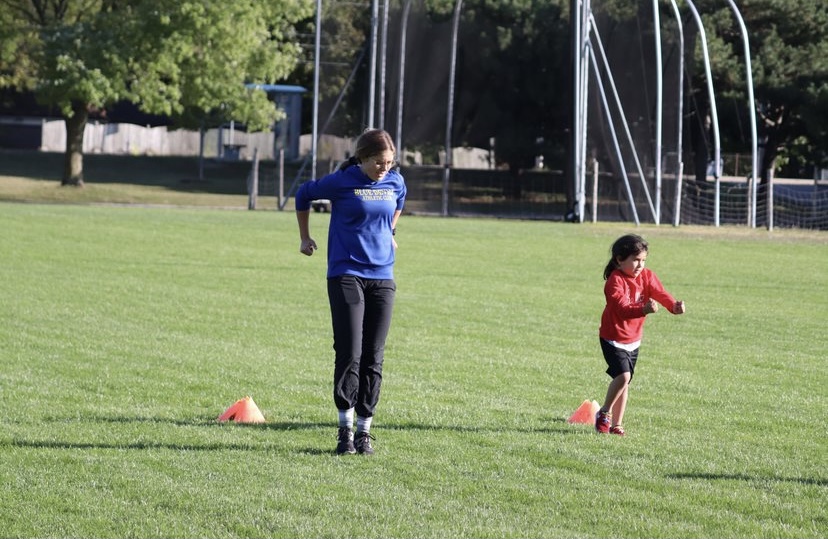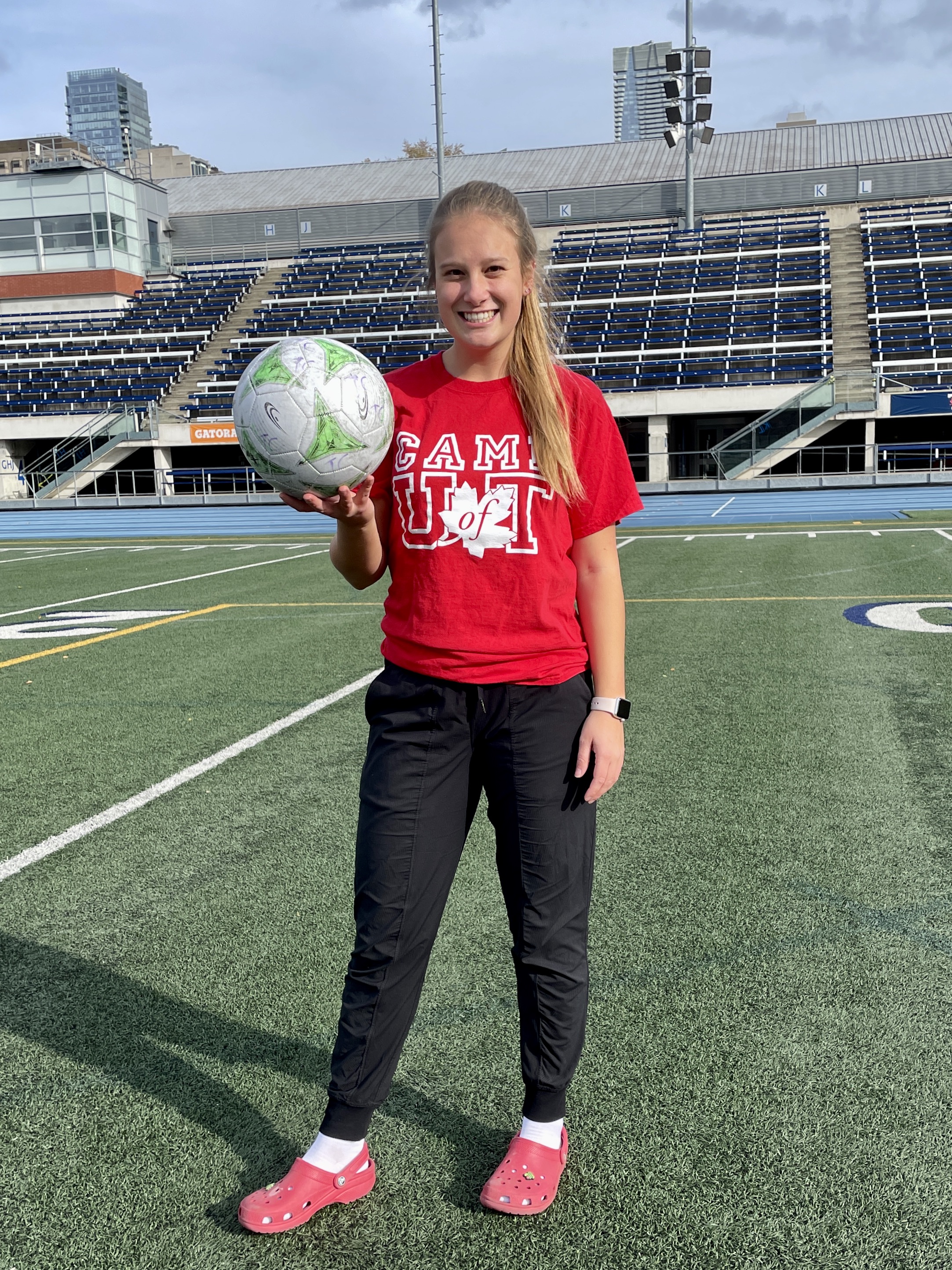Knowledge translation is a term often used in academia, but what does it really mean? Wikipedia tells us it is a spectrum of activities involved in moving research from the labs, journals and academic conferences into the hands of people and organizations who can put it to practical use.
Few things are more practical than physical education, so we turned to three students of the University of Toronto Faculty of Kinesiology and Physical Education (KPE) to find out how they’ve been translating content from their courses into practice.
Megan Torrance, Sephora Sandor and Stephen Stothers-Robertson have all gone through one or more courses on physical activity pedagogy taught by KPE Assistant Professor Tracia Finlay-Watson, who says “the content from each course can be directly applied to working with children, youth or adults in a physical activity setting.” 
Megan Torrance coaching a young athlete (photo courtesy of Megan Torrance)
Torrance, a third year student of kinesiology, has been applying some of that content in her work as a track and field coach in the Blue Devils athletic club in the Beaches, where she teaches large groups of three to six year olds.
“I’ve noticed my lessons becoming more effective, fun and inclusive after each new week of classes with Professor Finlay-Watson,” she says.
Finlay-Watson’s classes focus on developmental milestones and fundamental movement skills in early childhood – and how to teach them. The curriculum emphasizes the importance of imagination and encouragement over competition and performance.
“After a class discussion about the impact of competition-based activities on younger children, I started to notice it more in my work,” says Torrance. “The five to six year olds loved racing because they knew they were faster, but the younger children weren’t so keen on it because they couldn't run as fast.”
By eliminating the competitive aspect from the program, Torrance saw an immediate change in the younger children, who were suddenly more eager to participate “because they knew they could just run around and it didn’t matter how fast they went.”
She also started adding imaginative details to her classes, introducing creative themes to her warm-up activities and drills.
“For example, we would reach up to be tall like a giraffe, crab walk on hands and feet, gallop like a horse, leap like a frog, kick our feet back to be a donkey or sprint like a cheetah,” she says. “Not only did using these strategies help to keep the children engaged, they encouraged them to explore many types of movements on their own.”
Adding games and giving children the option to choose what game they wanted to play was something else she picked up from Finlay-Watson.
“She taught us that our goal as physical activity leaders is to promote a healthy relationship with activity, develop physical literacy and make sure physical activity is fun,” says Torrance. “I noticed a huge difference in the young athletes once I started focusing more on that approach.”
Sephora Sandor in her Camp U of T garb (photo courtesy of Sephora Sandor)
Sandor, a fourth year student of kinesiology, applied the content from her courses with Finlay-Watson to her job at Camp U of T last summer, where she taught basic sport skills to children between the ages of seven and 12 and coached sports - from basketball to kickball.
“Many of the course assignments catered to working with children during the pandemic, which was very helpful because I was able to use a lot of game ideas from the class discussion posts with the campers,” says Sandor.
The public health restrictions put in place to protect participants from COVID-19 made the concept of teaching sports challenging, but taking the course with Finlay-Watson left her feeling more prepared.
“The course focused heavily on age appropriate activities and the building of fundamental movement skills, so I would always ask myself, ‘Is this developmentally appropriate?’ before proceeding with an activity,” says Sandor. “I also tried to focus on teaching the fundamental skills before progressing to more complicated movements. For example, when I coached soccer, I would have all of the children in the younger age group practice standing on one foot before moving to striking. This broke down the movement and gave the children a chance to practice balancing before trying to kick the ball.”
Sandor also made sure that all the children were participating all the time.
“When planning obstacle course games, I planned them in such a way so as to ensure the children had an opportunity to get back in the game quickly if eliminated,” she says. “Children tend to disengage when they’re sitting out.”
Or when they’re bored - another lesson learned from Finlay-Watson.
“She told us that it’s better to over plan than to be underprepared,” says Sandor. “Children like structure and they like knowing what the plan is for the day. Even though it was “just” summer camp, I found lesson plans to be extremely helpful and felt the children respected me more as a leader.”
Headshot of Stephen Stothers-Robertson (courtesy of Stephen Stothers-Robertson)
Stephen Stothers-Robertson graduated from kinesiology in 2020 and is currently in his final year of a master of teaching degree at the Ontario Institute for Studies in Education (OISE), helping with the Built 2 Read program at Downsview Secondary School.
He singles out two key lessons from Finlay-Watson’s courses that he’s been applying successfully in grad school: the fundamentals of lesson planning and some pedagogical approaches to teaching health and physical education.
“Knowing how to plan and execute my lessons has played a large part in my success in my graduate studies,” he says. “Lesson planning is a big part of our course and practicum requirements and I was prepared for it going into the program. This was evident during my first practicum placement in the spring, where I was lesson planning for a de-streamed grade nine geography class and finding myself using tips and tricks from my kin class.”
Having the opportunity to observe Finlay-Watson and his peers use approaches such as Teaching Games for Understanding (TGfU), a teaching approach developed by researchers at Loughborough University in the United Kingdom to tap into children’s inherent desire to play, was also beneficial. .
“It meant I came to my Health and Physical Education (HPE) teachable course at OISE much better prepared,” he says. “The fundamentals of teaching and learning Professor Finlay-Watson shared with us in classes played such a large role in my continued teacher development.”
